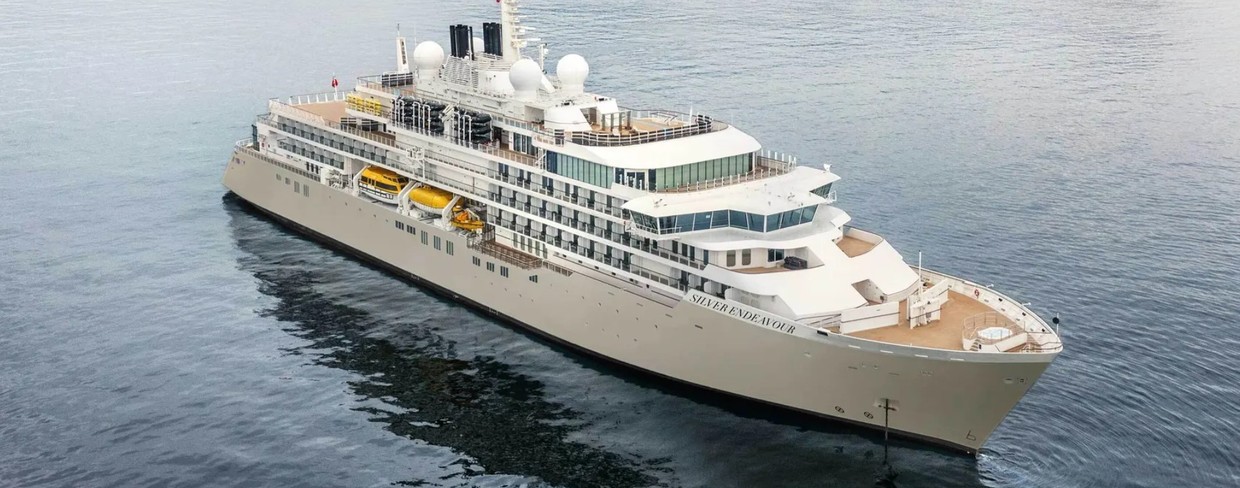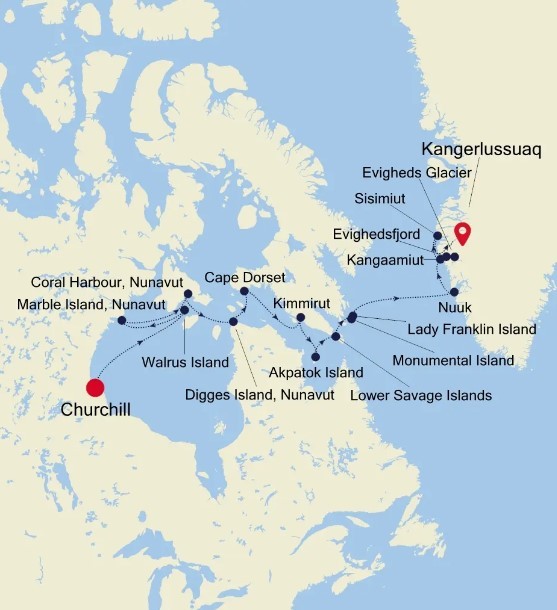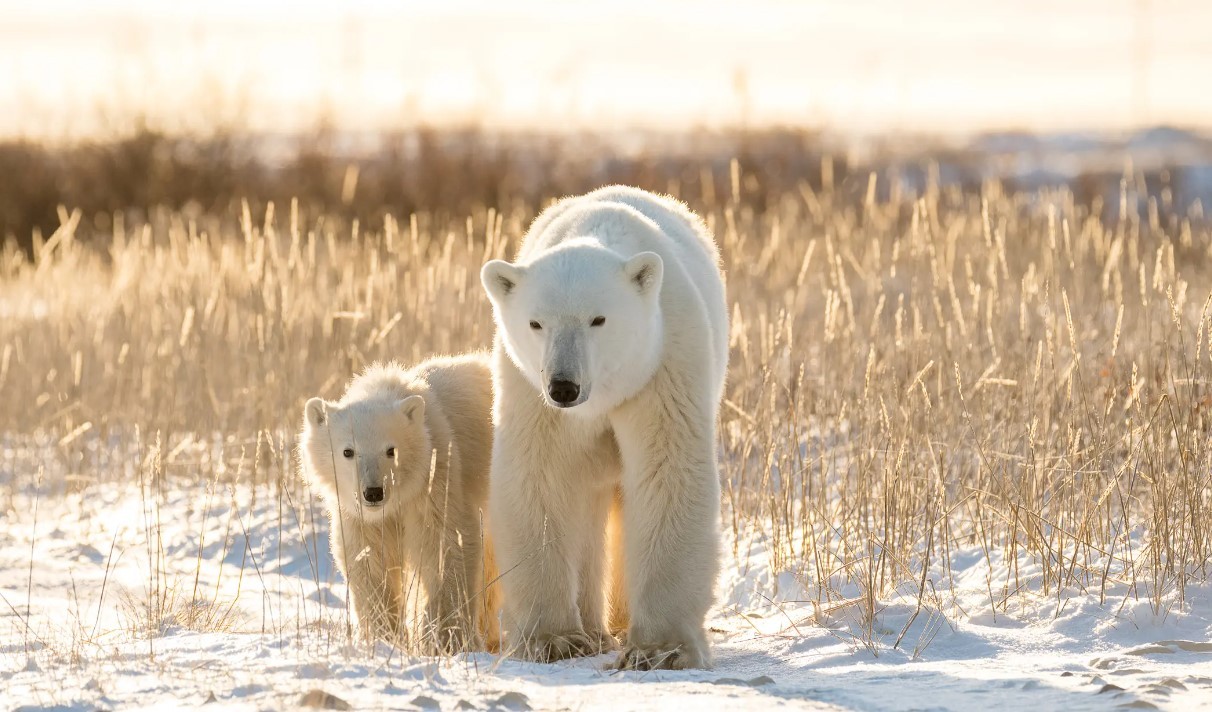from$ 30100 AUD
Note: Current p/p indicative rate. Final price may change due to currency fluctuations.
Silver Endeavour
Churchill to Kangerlussuaq
Overview
Expand your horizons with a thrilling Arctic Circle adventure among Canada’s ice-adapted wildlife, wonderful islands and far-flung cultures. Travel at this nose-bleedingly northerly latitude is always a precious thrill, and the Silver Endeavour gets you up close and personal with polar bears, breaching whales and creaking glaciers. Crunch through sea ice en route to Greenland’s incredible scenery, dropping in on cherry-red painted towns, dwarfed by spectacular, snow-clad mountains.
Departures
Cruise Itinerary
Archaeological evidence around Churchill indicates the former presence of Pre-Dorset, Dorset and Inuit groups, with the earliest date going back some 4,000 years. On the western shore of Hudson Bay and at the mouth of the Churchill River, Churchill became an important base for the Hudson’s Bay Company and the fur trade. Two forts were built in the early 18th century, both on the Canadian National Historic Site list. A Parks Canada Visitor Center in the VIA Rail Station shows exhibits of the human and natural history. Today Churchill is a town of about 1,000 inhabitants which can only be reached by rail on land, by air, and in the case of ships only between July and November. The deep-sea port facilitates primarily the transport of Western Canadian grains. Once the ice breaks up in the Churchill River Basin, beluga whales come to feed and rest by the hundreds. With sub-arctic tundra and boreal forests, the area between Churchill and Nelson River to the south is well-known as polar bear country. Churchill even has a Polar Bear Holding Facility, better known as the Polar Bear Jail.
Cape Dorset is a small Inuit hamlet located on Dorset Island off the southern shore of Baffin Island. The traditional name for Cape Dorset is Kinngait (meaning "high mountain") describing the ‘Cape’ which is actually a 800 foot mountain. This is a nature-lovers paradise with breath-taking landscapes and an amazing abundance of arctic wildlife such as migratory caribou seabirds whales seals and walruses. Ancient native Thule (Dorset Culture) peoples lived in this area for three thousand years and it is here where the first archaeological remains were found. Captain Luke Foxe during his attempt to find the Northwest Passage in 1631 was the first European to land here. He named the Cape in honour of his sponsor Edward Sackville the Earl of Dorset. In 1913 the Hudson's Bay Company started a trading post exchanging furs and skins for supplies like tobacco ammunition flour gas tea and sugar. In 1949 the market for white fox collapsed but the art industry boomed. Since the 1950s Cape Dorset the "Capital of Inuit Art" has become an economic mainstay of the community with more than 20% of it residents employed in the arts.
Kimmirut is a traditional Inuit hamlet of 455 people, located on the southernmost peninsula of Baffin Island, just across the Hudson Strait from mainland Québec. It is the southernmost community on Baffin Island. The name, translating as “the heel”, is named for a distinctive rocky outcrop that looks exactly like the back of your foot! First contact with Europeans occurred around 1000 AD when Dorset and Norse sailors from Greenland interacted. Intermittent contact continued between the Thule people and the Vikings for another 500 years. Interactions increased as fur hunters ventured farther and farther north, whalers came to Hudson Strait in search of bowhead whales, and Anglican missionaries arrived across the bay from the community in 1900. In 1911, the first Hudson Bay trading post on Baffin Island was built in Kimmirut. Today, Kimmirut, Formerly named Lake Harbour, is home to over four hundred people who preserve a traditional way of life, with a thriving culture of arts and crafts, including stone carving, ivory scrimshaw, and jewellery making using many gemstones native to this area.
Akpatok Island is a remote spot near the northernmost limits of the Labrador Peninsula. Steep and sheer limestone cliffs jut out of icy waters. Encased in snow and surrounded with sea ice in the winter months this uninhabited island lures huge amounts of wildlife most notably the world’s largest population of breeding Thick-billed Murres (known as Brünnich’s Guillemots in Europe) estimated at well over a million birds. These auks flock to the bare cliffs of the island between June and September and murres incubate their single pear-shaped egg on the cliff ledges. Glaucous Gulls can be seen soaring above looking for unguarded eggs and chicks while Black Guillemots paddle around on the nearby sea. Akpatok Island is also a favorite summer home for polar bears as they wait for the winter ice to form.
The Lower Savage Islands are a small group of islands off of the southeastern tip of Baffin Island, and a common location for polar bears to be found during the summer months. With plenty of land to roam while giving each other a wide berth, plus opportunities to feed, it seems perhaps bears can be found here as the ice vanishes with the summer season’s warming temperatures.
Named in honour of Sir John Franklin’s widow, the lonely and uninhabited Lady Franklin Island lies off of Baffin Island’s Hall Peninsula at the entrance to Cumberland Sound. The island is named for the wife of Sir John Franklin, the Arctic explorer who died trying to discover the Northwest Passage. The geology of the island is striking with vertical cliffs of Archean rocks, likely to be some of the oldest stone in Canada. The waters around Lady Franklin Island offer an abundance seabirds, ducks, seals, and walrus. With a bit of luck it is possible to see Atlantic Puffins here and perhaps even a rare Sabine’s Gull. Monumental Island is a splinter of ancient metamorphic rock, hunching in the frigid waters of the Davis Strait, defying the ocean and ice around it. Named to honour the legendary Polar Explorer Sir John Franklin, the island displays at times displays everything Nunavut has to offer, in an ocean studded with vast icebergs drifting across from Greenland. Monumental Island is a well known den site for polar bears, the icon of the Arctic; there is a good chance to see mother bears with cubs on the island, as the bears become trapped by the lack of summer ice, using the island as a base to hunt until the ice returns in the Autumn. Seeing the white silhouette of a polar bear against the ancient black rock and autumn tundra colours is an experience that will remain long after returning on board. Groups of harp seals are a common sight in the waters around Monumental Island, and can be very curious, often swimming very close to investigate new objects such as boats. There are several sites on the island also used as haul out sites for the charismatic Atlantic Walrus. These vast animals are surprisingly gentle and skittish, and can often be observed caring for their calves on the rock bluffs while keeping a careful watch for polar bears. Almost nowhere else in Nunavut can the charismatic wildlife of the Arcticbe observed in such a stunning setting.
Days at sea are the perfect opportunity to relax, unwind and catch up with what you’ve been meaning to do. So whether that is going to the gym, visiting the spa, whale watching, catching up on your reading or simply topping up your tan, these blue sea days are the perfect balance to busy days spent exploring shore side.
In the bustling capital city of Greenland, you could be forgiven for forgetting you are in such a vast and isolated country. Nuuk is Greenland's economic and social hub, home to more than a third of Greenland's population, and although it feels like a world capital, scratch the surface, and a uniquely Greenlandic character can be found underneath. Nuuk Cathedral overlooks the gorgeous old Colonial Harbour district and the Greenland National Museum, resting place of the legendary Qilakitsoq mummies, the true highlight of the museum's archaeological collection. Above the Colonial Harbour sits downtown Nuuk, with lines of Scandistyle apartments, a bustling shopping district, the Greenlandic Parliament, Nuuk City Hall (which welcomes visitors to see its artwork) and even outdoor cafes selling locally produced food and beer. These nods to modernity compete for space with local artisan boutiques, the meat market selling the catch from Nuuk's vast fjord-lands, and the stunning Katuaq Cultural Centre, where blockbuster movies, as well as local and foreign performers entertain the people of Nuuk. Although Nuuk has long been a melting pot of Danish and Greenlandic ideas, this is a city where Greenland displays its sophistication, with the Country's only traffic lights, roundabouts and University. Most of all, expect to find a multitude of friendly people who are proud of who they are, and equally proud of the city they call home.
Evighedsfjord (Eternity Fjord) is a large fjord northeast of Kangaamiut in southwest Greenland. The fjord has a length of 75 kilometers and several branches with numerous glaciers coming down from the Maniitsoq Ice Cap to the north can be seen. The Evighedsfjord has several bends and whenever the ship reaches the supposed end the fjord continues in another direction and seems to go on forever. Qingua Kujatdleq Glacier is at its southeastern end. At the northwestern end a U-shaped valley has seven glaciers coming down from the mountains but not reaching the water. The glaciers had their maximum extent around the year 1870 and have gone through several cycles of advance and retreat. The mountains on either side of the fjord can reach in excess of 2,000 meters and the fjord has a depth of up to 700 meters. Evighedsfjord’s snowline is at 1,100 meters and the Evighedsfjord region is famous as one of Greenland’s best heli-skiing areas. The Evigheds Glacier flows from the Greenland Ice Sheet, the second largest ice body in the world after the Antarctic ice sheet, to the west. It is a slow-moving tidewater glacier, meaning this valley glacier winds down through the coastal mountains to the ocean at a snail’s pace. As the glacial ice enters the water it begins to float and the eventually breaks apart into icebergs that float away down the fjord. The shades of blue and carved shapes of these ice floes are infinite. Kangaamiut (the People of the Fjords) is a settlement which clings to the shoreline of Greenland's Arctic Circle region, backed by some of the country's most spectacular fjordlands. The nearby pinnacle-shaped mountains gave the Danish-Norwegian colonial settlement its original name of Sukkertoppen (Sugarloaf) and the town recently celebrated its 250th anniversary. Here, one can experience small-town Greenlandic culture at its most authentic. The town is scattered across a small hill, displaying all the colourful buildings of the town at once; it is impossible to take a bad photo here. A system of staircases and boardwalks leads to the top of the hill, an area used to helicopter transport which offers jaw-dropping vistas of the wilderness around the settlement. The locals are proud of their Inuit history and culture, and the people of Kangaamiut are friendly and welcoming to vistors. Depending on the day, one could see local men selling fresh fish or reindeer meat from the surrounding fjords or flensing their catch on the rocks of the harbour, local women selling intricate homemade beaded necklaces and carvings, or even be invited into a local home to share a pot of coffee with some of the friendly residents, who are always happy to have visitors. Although the scenery is world-class, as in many towns in Greenland, wonderful memories of the welcoming residents are the most treasured.
Sisimiut ('The People of the Fox Holes') is Greenland's second city, the largest Arctic City in North America, and a hub between the warmer South and the frozen North of the country. With a young, dynamic population, including students from all over the country, Sisimiut is one of the fastest growing cities in Greenland. Inhabited for more than four and a half thousand years, the Danish Colonial Era saw the rapid development of the city into a trade centre, and the old buildings and artefacts can be seen at Sisimiut Museum, a collection of beautifully restored buildings displaying everything from ancient turf houses to modern Inuit art. The local artisans are considered some of the best in Greenland, and often sell their wares direct from their communal workshop in the harbour, where they barter with hunters for raw materials. Today, modern industry focussed on processing sea food and shipping; KNI, the state-run chain of general stores operating in even the most remote settlements is based in Sisimiut. Most residents still live in the colourful wooden houses Greenland is so well known for. Sisimiut's vast back country offers excellent opportunities for hiking and fishing, and the locals often use sled dogs or snowmobiles to get around their vast mountainous playground during the long winters. In the summer, one can walk as far as Kangerlussuaq International Airport, a trail also used for the gruelling Polar Circle Marathon, one of the toughest endurance events in the world.
Kangerlussuaq is a settlement in western Greenland in the Qeqqata municipality located at the head of the fjord of the same name (Danish: Søndre Strømfjord). It is Greenland's main air transport hub and the site of Greenland's largest commercial airport. The airport dates from American settlement during and after World War II, when the site was known as Bluie West-8 and Sondrestrom Air Base. The Kangerlussuaq area is also home to Greenland's most diverse terrestrial fauna, including muskoxen, caribou, and gyrfalcons. The settlement's economy and population of 512 is almost entirely reliant on the airport and tourist industry.
The excursions are provided as a sample of what may be offered on this voyage and are subject to change.
Silver Endeavour

Vessel Type: Luxury Expedition Length: 164.40 metres Passenger Capacity: 200 Built: 2021 Designed for polar exploration, Silver Endeavour breaks the ice of luxury expedition travel. We’re proud to announce that our newest addition has joined the fleet. Built to PC6 Polar Class specifications – one of the highest Polar Class classifications there is – Silver Endeavour revolutionises our expedition voyages, and allows us to travel deeper to some of the planet’s farthest flung coasts. Her statistics speak for themselves: from unrivalled, industry-leading crew-to-guest, zodiac-to-guest and expert-to-guest ratios, to cutting-edge navigation and exploration technology and hallmark Silversea comfort make her the most luxurious expedition ship ever built. Spread over eight public decks, not only does she feature ample onboard space, multiple restaurants, plus a huge choice of bars and lounges, but her large and luxurious suites are some of the best in expedition cruising. Superbly designed, all her suites feature a balcony and our highest standards of service thanks to an impressive crew-to-guest ratio of 1:1. Mud Room Silver Endeavour’s Mud Room is the perfect place to prepare for all your expedition activities. Spaciously designed, the two mud rooms are superbly modern, and equipped with state-of-the-art equipment. Explorer Lounge Strategically located mid-ship on deck 4, the Explorer Lounge is the operational heart of shore excursions while onboard. This is where you’ll attend your daily recap and briefing sessions or attend lectures. Connoisseur’s Corner The Connoisseur’s Corner is an indulgent and sophisticated cigar lounge, where you can enjoy an after dinner drink in a cosy private club atmosphere. Otium Spa Otium is where you can relax and unwind, but also where you can enjoy world class treatments that make sure you look as good as you feel and that even Venus herself would envy. Observation Lounge The Observation Lounge offers one of our favourite vantage points of Silver Endeavour. Plus 270-degree surrounding glass windows make this immersive venue ideal whatever time of the day. Beauty Salon Our committed and competent team of beauty therapists is here to help keep your hair, nails, skin, and body healthy and happy. Fitness Centre Whether you are a serious keep fit fanatic or casual athlete, you’ll find what you’re looking for in Silver Endeavour’s Fitness Centre. Expertly designed classes and personal training sessions make sure that you keep in shape. Boutique Located mid-ship on Deck 5, the Boutique aboard Silver Endeavour means luxury shopping experiences do not end just because you’re at sea! Carefully selected partners offer a wide selection of the latest fashions. Pool Deck Surrounded by glazing extended all the way to the top of the venue, the Pool Deck gives you the feeling of always being connected to the sea. The glass-enclosed pool deck is the ideal place to enjoy breathtaking views. Library Whether you’re an avid bibliophile or simply prefer a quiet place while at sea, it’s hard not to fall in love with Silver Endeavour’s onboard library, with its beautiful reference books, comfortable chairs and stunning scenery.
Highlights
• Churchill, Canada • Lady Franklin Island • Nuuk, Greenland • Evighedsfjord, Greenland • Evigheds Glacier, Greenland • Kangaamiut, Greenland • Kangerlussuaq, Greenland
Map



